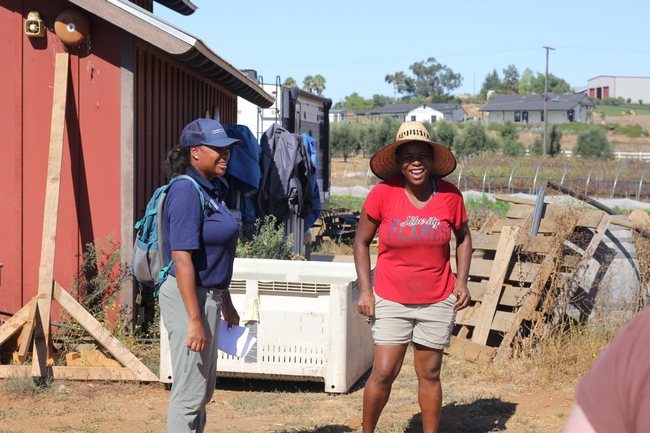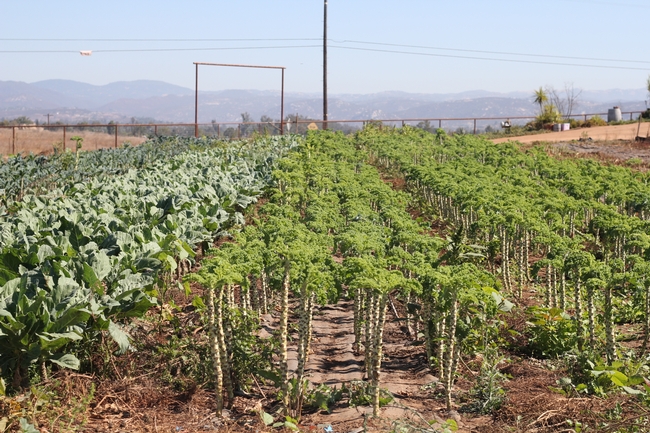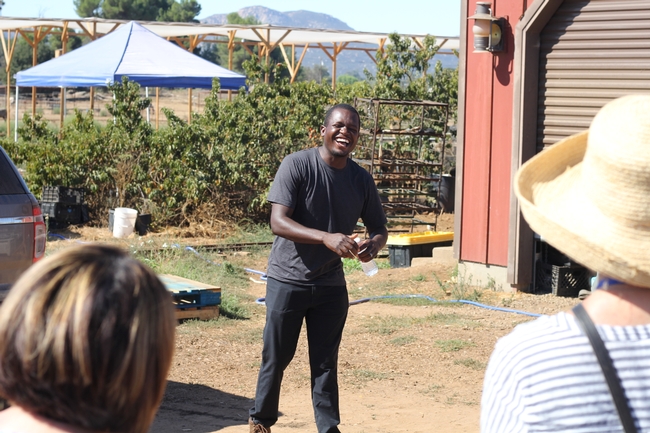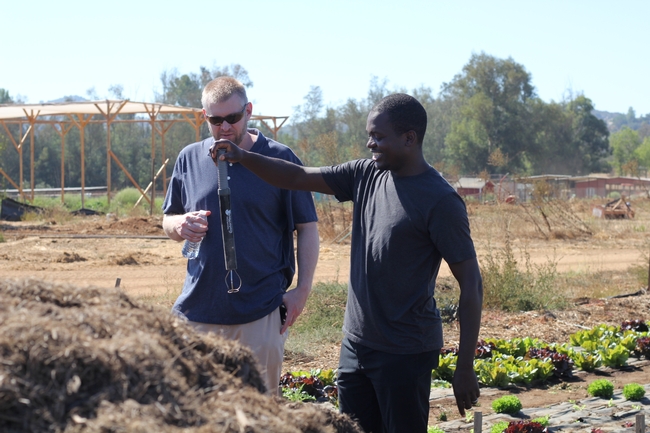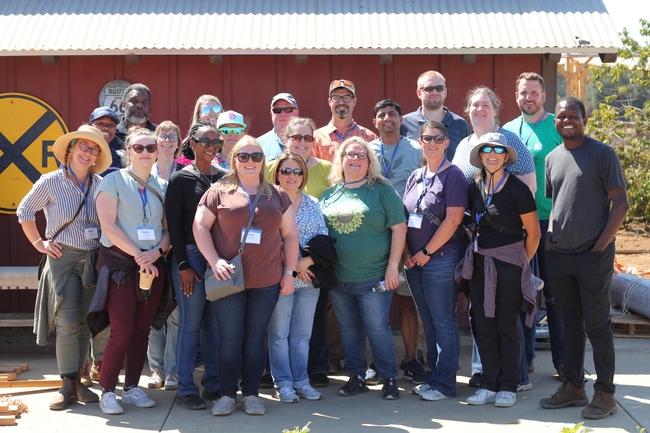Posts Tagged: October
UC ANR project to help underserved farmers in SoCal with land ownership
San Diego County has more than 5,000 small farms but less than 2% are operated or owned by Black, indigenous, or people of color – including those of Asian, Hispanic or Native Hawaiian/Pacific Islander descent, according to the 2022 Ag Census.
The reasons vary, but historically, multiple marginalized communities of color have not received the same opportunities or support for land ownership or management as their white counterparts.
Chandra Richards, University of California Cooperative Extension land equity academic coordinator for the Southern California region, is identifying barriers to equity when it comes to addressing land access, tenure, management and opportunities to increase the diversity of land managers and land ownership in the region.
Richards is the principal investigator for the Climate Action and Land Equity (CALE) project administered through UC Agriculture and Natural Resources and funded by the Department of Conservation. CALE aims to engage historically underrepresented communities in coalition building, capacity assessment and climate action planning. CALE elevates knowledge about the challenges and opportunities to land access and management for a diversity of land managers.
Among the challenges is land tenure, an established agreement between a landowner and tenant, outlining the purpose and use of the land over a period of time. However, when landowners decide to sell their land, these agreements are at risk of being null and void, forcing the tenants to renegotiate or discontinue their operation.
Land tenure leases for under five years are considered short-term, which are common in Southern California. For small, new and under-resourced farmers, landowner turnover doesn't just threaten their business plan but their livelihood.
For small farmer Byron Nkhoma, who leases land in Ramona to grow leafy greens and vegetables, the possibility of losing land is a constant worry. Since 2015, Nkhoma and his wife, Joyce, have been renting four of 20 acres to establish Hukama Produce. Over nine years, they have had two landowners. Before the land was sold to his current landowner, Nkhoma said he considered buying land, but the process proved more challenging than he thought.
“What it takes for someone like Byron to find a place to farm and establish a food system is an extremely involved process,” said Richards. “It's not just learning how to obtain land, it's also about managing that land so it can be used for years and generations to come.”
Originally from Zimbabwe, Nkhoma is adamant about taking care of the land he leases and has applied knowledge from his home to ensure resilience. Hukama Produce prides itself in improving environmental health through sustainable farming practices such as compost and mulch application, drip irrigation and low till. An important pillar of the CALE project includes building capacity and providing technical assistance toward land conservation and climate resiliency.
In addition to land tenure, money and time are stressors for small farmers. When they are not working on the farm, Nkhoma and his wife are researching and applying for grants to improve their soils and protect their crops from pests. However, many grants for which Hukama Produce is eligible often have pressing deadlines that demand their immediate attention – cutting into valuable time that could be spent tending to the land or selling at farmer's markets.
Two of Hukama's goals include building and sustaining trust in the market and growing their operation. By partnering with Richards, Hukama Produce has direct access to technical assistance focused on grant writing and conservation to increase ecosystem health and build tenure.
Agricultural land tenure is the arrangement, rights, and responsibilities centered around use, management, and ownership of agricultural land and resources. Building land tenure means that farmers have a stable place to grow their crops and build environmental sustainability without risk of having to move their operations.
While the CALE project boosts support for historically underserved community members hoping to own or manage land, it prioritizes land use for food production as a reinvestment into the greater community.
Eager to bring realities like Nhkoma's to light, Richards partnered with Keith Nathaniel, UCCE director for Los Angeles County, who co-coordinated the Western Extension Leadership Development conference held in San Diego the week of Sept. 23-27. WELD unites Cooperative Extension faculty, agents, advisors, educators and specialists from the western region of the United States for a two-year leadership development program.
While in San Diego, WELD participants joined Richards for a tour of Hukama Produce and learned directly from Nkhoma about opportunities and threats as a small farmer. The tour ended with participants in a circle, sharing how their professional roles can offer support to Hukama Produce and other small farms.
“We grow food so that we can feed the community,” said Nkhoma. “When we feed others, we build relationships. That's what ‘hukama' means – to grow relationships.”
If you operate or know of a small farm in Southern California and would like to be involved with or receive regular updates about the CALE project, please contact Chandra Richards at cmrichards@ucanr.edu.
If you are interested in applying for the Land Equity Project Manager position, please visit https://ucanr.edu/About/Jobs/?jobnum=2894 for details.
Happy Arachtober!
It's October and Arachtober: the month to celebrate spiders and other arachnids. As arachnologists will tell you, arachnids are arthropods that include spiders, scorpions, ticks, mites, pseudoscorpions, harvestmen, camel spiders, whip spiders and...

Pretty in pink. A jumping spider on a pink rose in a Vacaville garden peers at the photographer. (Photo by Kathy Keatley Garvey)

Pretty in yellow. A jumping spider on a yellow rose in a Vacaville garden peers at the photographer. (Photo by Kathy Keatley Garvey)
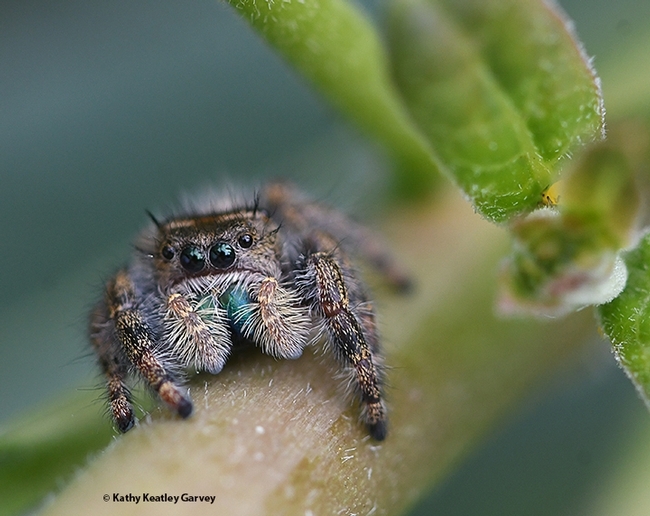
Pretty in green. A jumping spider on green vegetation in a Vacaville garden peers at the photographer. (Photo by Kathy Keatley Garvey)
Lawn-pocalypse! Surviving Drought
Ah, summer! The season of sunburns, pool parties, and… lawn droughts. If your once lush, green carpet now looks like a crunchy brown doormat, you're not alone. Let's dive into why your yard is staging a dramatic death scene and what you can do to...

Bermuda grass and weeds overtaking drought stressed turf grass.
Climate-Change Resources
University of California UC ANR Green Blog (Climate Change and Other Topics) https://ucanr.edu/blogs/Green/index.cfm?tagname=climate%20change (full index)
Examples:
- Save Trees First: Tips to Keep Them Alive Under Drought https://ucanr.edu/b/~CdD
- Landscaping with Fire Exposure in Mind: https://ucanr.edu/b/~G4D
- Cities in California Inland Areas Must Make Street Tree Changes to adapt to Future Climate https://ucanr.edu/b/~oF7
Drought, Climate Change and California Water Management Ted Grantham, UC Cooperative Extension specialist (23 minutes) https://youtu.be/dlimj75Wn9Q
Climate Variability and Change: Trends and Impacts on CA Agriculture Tapan Pathak, UC Cooperative Extension specialist (24 minutes) https://youtu.be/bIHI0yqqQJc
California Institute for Water Resources (links to blogs, talks, podcasts, water experts, etc.) https://ciwr.ucanr.edu/California_Drought_Expertise/
UC ANR Wildfire Resources (publications, videos, etc.) https://ucanr.edu/News/For_the_media/Press_kits/Wildfire/ (main website)
-UC ANR Fire Resources and Information https://ucanr.edu/sites/fire/ (main website)
-Preparing Home Landscaping https://ucanr.edu/sites/fire/Prepare/Landscaping/
UC ANR Free Publications https://anrcatalog.ucanr.edu/ (main website)
- Benefits of Plants to Humans and Urban Ecosystems: https://anrcatalog.ucanr.edu/pdf/8726.pdf
-Keeping Plants Alive Under Drought and Water Restrictions (English version) https://anrcatalog.ucanr.edu/pdf/8553.pdf
(Spanish version) https://anrcatalog.ucanr.edu/pdf/8628.pdf
- Use of Graywater in Urban Landscapes https://anrcatalog.ucanr.edu/pdf/8536.pdf
- Sustainable Landscaping in California https://anrcatalog.ucanr.edu/pdf/8504.pdf
Other (Non-UC) Climate Change Resources
Urban Forests and Climate Change. Urban forests play an important role in climate change mitigation and adaptation. Active stewardship of a community's forestry assets can strengthen local resilience to climate change while creating more sustainable and desirable places to live. https://www.fs.usda.gov/ccrc/topics/urban-forests
Examining the Viability of Planting Trees to Mitigate Climate Change (plausible at the forest level) https://climate.nasa.gov/news/2927/examining-the-viability-of-planting-trees-to-help-mitigate-climate-change/
Reports and other information resources coordinated under the auspices of the United Nations and produced through the collaboration of thousands of international scientists to provide a clear and up to date view of the current state of scientific knowledge relevant to climate change. United Nations Climate Action
Scientific reports, programs, action movements and events related to climate change. National Center for Atmospheric Research (National Science Foundation)
Find useful reports, program information and other documents resulting from federally funded research and development into the behavior of the atmosphere and related physical, biological and social systems. Search and find climate data from prehistory through to an hour ago in the world's largest climate data archive. (Formerly the "Climatic Data Center") National Centers for Environmental Information (NOAA)
Think tank providing information, analysis, policy and solution development for addressing climate change and energy issues (formerly known as the: "Pew Center on Global Climate Change"). Center for Climate & Energy Solutions (C2ES)
Mapping Resilience: A Blueprint for Thriving in the Face of Climate Disaster. The Climate Adaptation Knowledge Exchange (CAKE) was launched in July 2010 and is managed by EcoAdapt, a non-profit with a singular mission: to create a robust future in the face of climate change by bringing together diverse players to reshape planning and management in response to rapid climate change. https://www.cakex.org/documents/mapping-resilience-blueprint-thriving-face-climate-disaster
Cal-Adapt provides a way to explore peer-reviewed data that portrays how climate change might affect California at the state and local level. We make this data available through downloads, visualizations, and the Cal-Adapt API for your research, outreach, and adaptation planning needs. Cal-Adapt is a collaboration between state agency funding programs, university and private sector researchers https://cal-adapt.org/
Find reports, maps, data and other resources produced through a confederation of the research arms of 13 Federal departments and agencies that carry out research and develop and maintain capabilities that support the Nation's response to global change. Global Change (U.S. Global Change Research Program)
The Pacific Institute is a global water think tank that combines science-based thought leadership with active outreach to influence local, national, and international efforts to develop sustainable water policies. https://pacinst.org/our-approach/
Making equity real in climate adaptation and community resilience policies and programs: a guidebook. https://greenlining.org/publications/2019/making-equity-real-in-climate-adaption-and-community-resilience-policies-and-programs-a-guidebook/
Quarterly CA Climate Updates and CA Drought Monitor Maps (updated each Thursday) https://www.drought.gov/documents/quarterly-climate-impacts-and-outlook-western-region-june-2022
Drought focus of Water Resources IMPACT magazine special issue
UC ANR experts address emotional toll of drought
Preparing the American West for prolonged drought is the focus of a double issue of Water Resources IMPACT magazine. The California Water Commission staff are guest editors for this special open-access edition of the magazine, which is published by the American Water Resources Association.
Faith Kearns, academic coordinator of University of California Agriculture and Natural Resources' California Institute for Water Resources, is among the authors delving into how drought impacts people and the environment and how we can better prepare for the inevitable.
The first issue, published on Feb. 14, focuses on water scarcity issues confronting California and the ways these issues affect different sectors.
In “Trauma, Care, and Solidarity: Addressing the Emotional Toll of Chronic Drought,” Kearns highlights the effects of drought on mental health. She points to the spike in suicide hotline calls when wells ran dry in Southeast Asian communities in California's Central Valley.
By listening to Southeast Asian farmers, Ruth Dahlquist-Willard and Michael Yang of UC Cooperative Extension were able to “lighten the load” for them by providing pragmatic support, Kearns writes.
“The scale of some of these highly emotional issues – drought, wildfires, climate change – can make them seem incredibly difficult, if not impossible, to deal with,” Kearns said. “At the same time, they are affecting everyone living in the western U.S. on a daily basis. I wanted to highlight and provide models based on work that people – whether they are researchers, clinical psychologists, or Cooperative Extension advisors – are doing right now to ease the way.”
The authors who contributed to the double issue are a diverse array of Tribal experts, academics, nongovernmental organization thought-leaders, water managers and water policy influencers, each of whom brings their own perspective on the topic of drought. Their expertise and perspectives in climate science, water policy and water management will help inform drought-related decision-making and support policies that better prepare the state to thrive during periods of prolonged water scarcity.
In addition to Kearns, the first issue includes articles contributed by:
- Samantha Stevenson, University of California, Santa Barbara
- Jay Lund, University of California, Davis
- Ron Goode, North Fork Mono Tribe
- Andy Fecko, Placer County Water Agency
- Jeff Mount, Public Policy Institute of California, and Ted Grantham, University of California, Berkeley/UC Cooperative Extension
- Nat Seavy and Karyn Stockdale, National Audubon Society
- Kjia Rivers, Community Water Center
- Cannon Michael, Bowles Farming
- Michelle Reimers, Turlock Irrigation District
The January/February edition of Water Resources IMPACT magazine can be accessed, free of charge, on the American Water Resources Association website at https://www.awra.org under “Publications.”
The second issue, to be published in March, will focus on drought response, considering the options for adaptation. This two-part series complements the Commission's work on strategies to protect communities and fish and wildlife in the event of a long-term drought.

